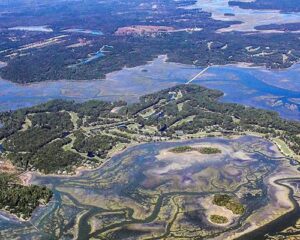
Our Island
It’s often said Callawassie Island captures you from the causeway. As you drive down the ¼-mile stretch into our island, you’ll leave behind the hectic world and enter paradise. One of South Carolina's hundreds of sea and barrier islands, Callawassie Island is an 880-acre private oasis comprised of coastline, marshes, and moss-draped oaks. Here, we share in a deep appreciation of our stunning Lowcountry landscape, and we are proud to have been designated as the first Community Wildlife Habitat in our state. As you navigate the island's bike paths and coastal waters, you will feel connected to yourself, your neighbors, and the surrounding nature.
Our History
In the early 17th century, the Yemassee Indian Tribe, who inhabited the island and the surrounding Lowcountry, gave Callawassie its name, translating to “calm waters.” In the early 1800’s, the island was owned by James Hamilton, a lawyer and politician who served as mayor of Charleston and also as South Carolina’s governor. It is believed that Hamilton oversaw the development of Callawassie Sugar Works, a complex for processing sugar cane into sugar, though the actual architect is unknown. The old mill's tabby remnants can be found on the island to this day and are the only example of industrial tabby in the entire state. Over the centuries, the island housed a thriving indigo plantation, and also served as a southern playground for some of the nation’s elite. It was in 1981 that Callawassie Island established its modern identity and has since evolved into the flourishing, private community it is today.


Our Residents
Whether recent retirees, young professionals, or those choosing to have a second home, all residents of Callawassie Island share a common interest in the island community and its wellbeing. The private, welcoming, and relaxed setting of Callawassie Island promotes strong connections between residents and the surrounding landscape. With more than 50 active clubs, Callawassie Island's golfers, paddlers, tennis players, fishermen, gardeners, and more are encouraged to share in their interests, delve into their crafts, and socialize through island-wide events and activities.

Our Island
It’s often said Callawassie Island captures you from the causeway. As you drive down the ¼-mile stretch into our island, you’ll leave behind the hectic world and enter paradise. One of South Carolina's hundreds of sea and barrier islands, Callawassie Island is an 880-acre private oasis comprised of coastline, marshes, and moss-draped oaks. Here, we share in a deep appreciation of our stunning Lowcountry landscape, and we are proud to have been designated as the first Community Wildlife Habitat in our state. As you navigate the island's bike paths and coastal waters, you will feel connected to yourself, your neighbors, and the surrounding nature.

Our History
In the early 17th century, the Yamassee Indian Tribe, who inhabited the island and the surrounding Lowcountry, gave Callawassie its name, translating to “calm waters.” In the early 1800’s, the island was owned by James Hamilton, a lawyer and politician who served as mayor of Charleston and also as South Carolina’s governor. It is believed that Hamilton oversaw the development of Callawassie Sugar Works, a complex for processing sugar cane into sugar, though the actual architect is unknown. The old mill tabby remnants can be found on the island to this day and are the only example of industrial tabby in the entire state. Over the centuries, the island housed a thriving indigo plantation, and also served as a southern playground for some of the nation’s elite. It was in 1981 that Callawassie Island established its modern identity and has since evolved into the flourishing, private community it is today.

Our Residents
Whether recent retirees, young professionals, or those choosing to have a second home, all residents of Callawassie Island share a common interest in the island community and its wellbeing. The private, welcoming, and relaxed setting of Callawassie Island promotes strong connections between residents and the surrounding landscape. With more than 50 active clubs, Callawassie Island's golfers, paddlers, tennis players, fishermen, gardeners, and more are encouraged to share in their interests, delve into their crafts, and socialize through island-wide events and activities.

